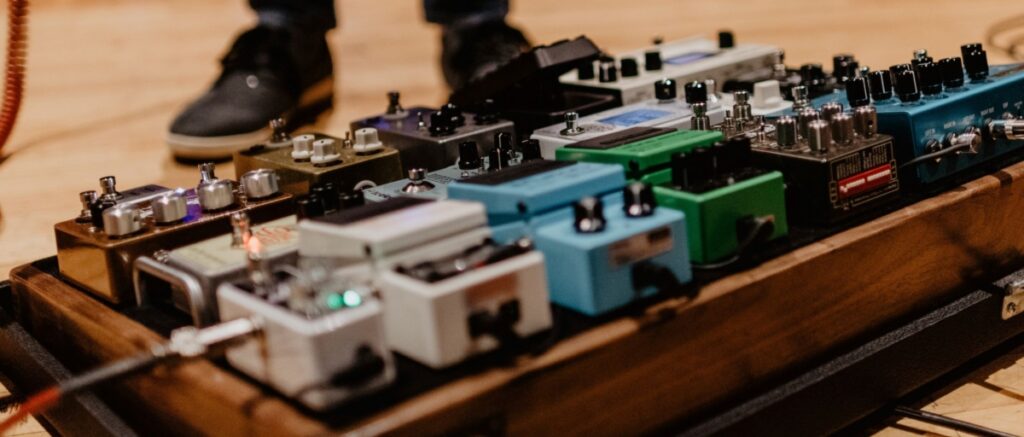Volume and boost are two very popular types of electric guitar effects pedals. They are often confused with one another but actually work very differently so in this article I’ll explain exactly how they work and how to decide which is the best option for you. Let’s start with the quick answer…
Volume vs Boost Pedal 101
Volume pedals work by limiting the signal, whereas boost pedals work by increasing it. Boost pedals can either increase the volume, gain or both. When placed at the end of the chain, volume pedals only affect the volume, but when placed at the start so they also affect the gain but not as much as a boost.

Function of a Boost Pedal
The function of a boost pedal is to either add more volume and/or gain by increasing your signal level.
There are two main types of boost pedals:
- Clean boost
- Coloured boost
Clean Boost
Clean boost pedals just have a volume control and will increase the signal level to give you more volume without adding gain or changing the tone. Some “clean boost” pedals will colour the tone slightly, usually by increasing the treble or mids but the main focus is to simply increase the volume.
It’s worth noting though that a clean boost pedal will only achieve this effect if you place it after any gain pedals (overdrive, distortion or fuzz), and into a clean amp. Otherwise it will push either the gain pedals or the amp and create an overdriven sound as well as a volume increase.
For the purest clean boost, put the pedal if your effects loop. This will ensure the sound of your amp/ pedals remains the same and only the volume will be altered.
Option 1:

Option 2:

Option 3:

Coloured Boost
Coloured boost pedals will usually have 3 controls, level (aka volume), gain and tone. The gain control will allow you to achieve a “dirty boost” effect by increasing both the volume and the gain. The tone control will allow you to adjust the colour of the signal as well.
Coloured boost pedals can essentially be used to boost the gain only, or both the volume and gain depending on how you set them up.
Function of a Volume Pedal
A volume pedal is operated by either pushing downwards or rocking backwards on it. By rocking backwards on the volume pedal you will decrease the volume. What’s important to note is that when you push downwards on the pedal, you are not really increasing the volume, you are just not limiting it like you would be if you pressed downwards on it.
Check out this diagram to demonstrate.

The easiest way to think about the volume pedal is to compare it to the volume control on your electric guitar.
Having the volume control on your guitar at 10 allows the full signal to pass through, whereas turning it down will limit it. Not only does this reduce the actual volume, but it also reduces the gain and treble. This is how a volume pedal functions when you place it at the start of the chain (immediately after your guitar).
Alternatively, you can place the volume pedal at the end of the pedal chain directly before the amp so it’ll act as a master volume. This means that if you are using gain pedals (e.g. overdrive, distortion or fuzz), then the volume pedal will not affect the gain, and will only affect the volume.
Check out my complete guide to volume pedals to learn more.
Difference Between Volume and Boost Pedals
To start with, let’s just consider clean boost pedals (as opposed to coloured boost pedals as well) and volume pedals.
Both pedals can be used to adjust the overall volume, but they work in different ways.
- Boost pedals boost the signal to increase the volume
- Volume pedals limit the signal to decrease the volume
Let’s take a look at this diagram to demonstrate.

Volume pedals work by limiting the signal to lower the volume when left in the open position. When you press down on the pedal, the limit is lifted so the volume increases to its maximum level (the same as it would be if there was no volume pedal plugged in). It does not increase the signal. Boost pedals on the other hand increase the signal.
Essentially, with a volume pedal you have the option to either have the volume at a natural level or at a lower level. Whereas, with a boost pedal, you have the option to have the volume at a natural level, or at a higher level.

Dirty Boost vs Volume Pedals
Okay, so what about coloured/dirty boost pedals? These are capable of having a much greater effect on the gain and tone compared to volume pedals. Unlike volume pedals, a dirty boost pedal can be used to just increase the gain, rather than the volume as well if you put them through a gain pedal/ dirty amp.
Volume pedals do have some effect on the tone and gain if you put them at the start of your pedal chain, just not nearly as much as dirty boost pedals do though.
Which Pedal is Best for You?
Consider this question…
Do you want the option to either
a) Limit your signal
b) Increase your signal
Personally, I find a boost pedal most useful for solos. I personally like to increase the gain and volume most of the time so will either place a clean boost before my overdrive pedal, or a dirty boost after it to kick things up a notch. I find this much easier compared to using a volume pedal. My preferred function of a volume pedal is for volume swells where I find it most useful.
Organising a pedalboard? Check out my ultimate guide to designing a pedalboard including all the equipment you need and a step by step formula to getting set up in a pain-free way.
